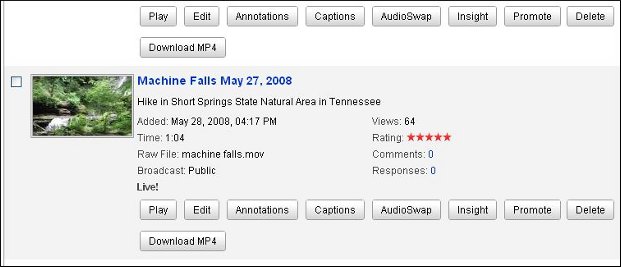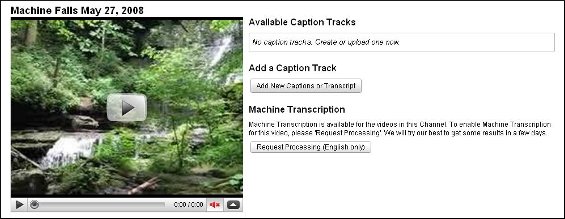Using Video on your Website

If you’re not using video on your website, you should be. Any business can use video on their website to improve their branding and profits. In fact, small businesses have been quick to adopt video on their websites. The number of small businesses using video on their websites at the end of 2009 was four times as great as only one year earlier. Video capability was the single fastest growing feature small businesses added to their websites. On-page video is one of the best known ways to engage an audience and it’s also a way to position your business right in front of those who are seeking out your product or service using search engines.
You can use video to showcase how to use a product, to show testimonials, to highlight a product’s features, or to upload clips made by customers about the product. Since search engines used to have to ignore video, everyone pretty much dismissed video. But now Google’s universal search format, which includes videos, news, blogs, maps, and other so-called vertical search content is making video more relevant than ever. Another factor driving the importance of video in SEO is the increasing saturation of broadband internet coverage. And there’s the simple fact that people like watching short videos. We’ve all watched funny cat or “fail” videos on our coffee break. Given all this, it makes sense to do what you can to optimize video content for search engines.
Keep in mind that Google searches the whole web to find text, but it only searches Google Video and YouTube for video. If you put your video onto Google Video and YouTube, it’s very important to link back to your own site. Otherwise you get nothing for your effort. But putting video on your website and on various video upload sites is only half the battle. There are a number of steps you can take to optimize the video you host directly on your website:
- Make sure the video is surrounded by HTML content so that the search engines can get extra information from the surrounding page. Information gathered from within the video itself will be rather limited.
- The filename, title, and description should be relevant. They are necessary, but not sufficient for your video to rank well.
- Optimize video file metadata by encoding keywords into the video’s meta data. Tag videos with specific keywords
- Since a lot of people add the word “video” to their search query keyword phrase, you should add the word “video” to your title, your description, and meta data.
- Add back links from the video to your home page, or even a page on a video sharing site that you want to boost in rank. It’s also a good idea to link to videos using keywords in anchor text.
- To help web crawlers find all your online video content, create an RSS, sitemap, or media RSS file to assist search engines in identifying where to find and index your videos.
- Keeping video content in one place off your root directory makes it easy to find for search engine crawlers. Upload all future videos to this same folder.
- Stay away from Flash video players because search engines have a tough time with video content inside of Flash players.
- Avoid pop-up video players on your site because of the prevalence of pop-up blockers.
- Optimize URLs so that they contain information about the video. Keep it to one video per URL for optimum SEO.
- Submit your videos to search engines that accept RSS or MRSS
- Solicit friends to submit your video on social media sites.
For video hosted on video sharing sites and video search engines, you should do most of the same things as for video hosted on your own website. You want to have good thumbnails, and good first and last frames. The video thumbnail is what your users see when they’re deciding whether or not to watch your video. Video search engines grab thumbnails in different ways. Some grab a random frame from somewhere in the middle, while others will take the first frame. It may take some experimentation with the video length to ensure a great thumbnail from the various video search engines.
In your first and last frames, place your logo, your URL, and any other vital information that applies. Video search engines are starting to “learn” how to use optical character recognition, voice recognition, and image recognition. As this technology matures, SEO for videos may change, but the state of the art right now is that you need to rely on meta data and keywords.
Though it’s a slight variation on the subject, a new technology coming up on the horizon is auto-captioning of videos. There are an estimated 700 million people all over the world who have some degree of hearing impairment. There are probably millions of others who want to watch a video, but don’t want to turn off the music they’re listening to. To this end, YouTube recently opened auto-captioning up to everyone
Auto-captioning uses speech-to-text technology to generate video captions when requested by a viewer. They’re also going through videos from the past and auto-generating captions for many of those. You can download the captions that have been generated, edit them, and then replace the auto-generated captions with the corrected ones. You can even have your captions translated into other languages. Right now, auto-captioning is only available for English-speaking videos, and there are the pitfalls that you might expect (background noise, muffled voices, extreme accents, etc.). As you might expect, auto-captioning works best for video with a clearly spoken vocal track, such as a speech or oral presentation.
You can see in the first two screen shots how to add captions or ask for captions to be generated. The best part is in the third screen shot: Google indexes the caption files, giving you yet another chance to improve your site’s SEO!










